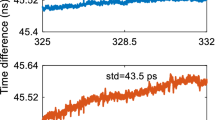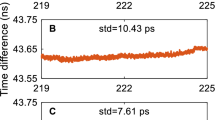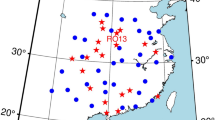Abstract
A time transfer model with Global Navigation Satellite System (GNSS) carrier phase using precise point positioning (PPP), integer PPP (IPPP), single-difference (SD) and integer SD (ISD) modes between two stations is studied. To overcome the difficulty of being unable to fix the SD ambiguity due to the influence of the uncalibrated phase delay (UPD) at the receivers, the SD ambiguity is resolved with the constraint of the fixed double-difference (DD) ambiguity among several stations and satellites. Here the SD and ISD time transfer algorithms are extended to Global Positioning System (GPS), BeiDou Navigation Satellite System (BDS), Galileo Navigation Satellite System (Galileo), and Global Navigation Satellite System (GLONASS). As an example, taking four long-baseline links between pairs of ground stations, BRUX–OPMT, BRUX–PTBB, BRUX–WTZR and BRUX–CEBR, the performances of the carrier-phase ISD, IPPP, SD, and the PPP time transfer of the GPS, BDS, Galileo, and GLONASS systems are compared and analyzed. The results show that the SD and PPP time transfer precisions are equivalent, and the performances of GPS and Galileo are better than those of BDS and GLONASS. With an ambiguity resolution, the frequency instability in time transfer can reach sub 10–16 level after 5 days. The positioning accuracies of fixed solutions are improved compared with float solutions, and the positioning accuracies of ISD are slightly better than that of IPPP. Although the short-term frequency stabilities of IPPP and ISD did not improve over PPP and SD, the long-term frequency stabilities of IPPP and ISD all improved roughly 15% on average. The ISD is suitable for short and middle-long baselines time transfer, while IPPP is suitable for ultra-long baseline time transfer. The time transfer model provided in this study could be applied to gravity potential determination.














Similar content being viewed by others
Data availability
The observation data from MGEX networks are available at https://gdc.cddis.eosdis.nasa.gov/gps/data/daily/. The precise orbit and clock products are available at https://gdc.cddis.eosdis.nasa.gov/gps/products/mgex/. The DCBs are provided at the http://ftp.gipp.org.cn/product/dcb/mgex/.
References
Allan DW, Weiss MA (1980) Accurate time and frequency transfer during common-view of a GPS satellite. In: Proceedings of the 1980 IEEE frequency control symposium, Philadelphia, PA, USA, May 28–30, pp 334–346
Böhm J, Heinkelmann R, Schuh H (2007) Short note: a global model of pressure and temperature for geodetic applications. J Geod 81:679–683. https://doi.org/10.1007/s00190-007-0135-3
Böhm J, Niell A, Tregoning P, Schuh H (2006) Global mapping function (GMF): a new empirical mapping function based on numerical weather model data. Geophys Res Lett 33:3–6. https://doi.org/10.1029/2005GL025546
Chang XW, Yang X, Zhou T (2005) MLAMBDA: a modified LAMBDA method for integer least-squares estimation. J Geod 79:552–565. https://doi.org/10.1007/s00190-005-0004-x
Chuang S, Wenting Y, Weiwei S, Yidong L, Yibin Y, Rui Z (2013) GLONASS pseudorange inter-channel biases and their effects on combined GPS/GLONASS precise point positioning. GPS Solut 17:439–451. https://doi.org/10.1007/s10291-013-0332-x
Defraigne P, Baire Q (2011) Combining GPS and GLONASS for time and frequency transfer. Adv Space Res 47:265–275. https://doi.org/10.1016/j.asr.2010.07.003
Defraigne P, Bruyninx C J I (2006) Multipath mitigation in GPS-based time and frequency transfer. In: Proceedings of the 20th European Frequency and Time Forum, pp 524–529
Delporte J, Mercier F, Laurichesse D, Galy O (2008) GPS carrier-phase time transfer using single-difference integer ambiguity resolution. Int J Navig Obs 2008:273785. https://doi.org/10.1155/2008/273785
Gao W, Gao C, Pan S (2016) A method of GPS/BDS/GLONASS combined RTK positioning for middle-long baseline with partial ambiguity resolution. Surv Rev 49:212–220. https://doi.org/10.1179/1752270615y.0000000047
Gao W, Gao C, Pan S, Meng X, Xia Y (2017) Inter-system differencing between GPS and BDS for medium-baseline RTK positioning. Remote Sens. https://doi.org/10.3390/rs9090948
Ge M, Gendt G, Rothacher M, Shi C, Liu J (2007) Resolution of GPS carrier-phase ambiguities in precise point positioning (PPP) with daily observations. J Geod 82:389–399. https://doi.org/10.1007/s00190-007-0187-4
Ge Y, Qin W, Cao X, Zhou F, Wang S, Yang X (2018) Consideration of GLONASS inter-frequency code biases in precise point positioning (PPP) international time transfer. Appl Sci 8:12541. https://doi.org/10.3390/app8081254
Ge Y, Chen S, Wu T, Fan C, Qin W, Zhou F, Yang X (2021) An analysis of BDS-3 real-time PPP: time transfer, positioning, and tropospheric delay retrieval. Measurement 172:108871. https://doi.org/10.1016/j.measurement.2020.108871
Hatch R (1982) The synergism of GPS code and carrier measurements. In: Proceedings of the third international symposium on satellite doppler positioning at Physical Sciences Laboratory of New Mexico State University, vol. 2, pp 1213-1231
Katsigianni G, Loyer S, Perosanz F (2019a) PPP and PPP-AR kinematic post-processed performance of GPS-Only Galileo-Only and Multi-GNSS. Remote Sens 11:2447. https://doi.org/10.3390/rs11212477
Katsigianni G, Loyer S, Perosanz F, Mercier F, Zajdel R, Sośnica K (2019b) Improving Galileo orbit determination using zero-difference ambiguity fixing in a Multi-GNSS processing. Adv Space Res 63:2952–2963. https://doi.org/10.1016/j.asr.2018.08.035
Kouba J (2009) A guide to using International GNSS Service (IGS) products IGS Central Bureau. Jet Propulsion Laboratory, Pasadena, p 34
Laurichesse D, Mercier F, Berthias JP, Broca P, Cerri LJN (2009) Integer ambiguity resolution on undifferenced GPS phase measurements and its application to PPP and satellite precise orbit determination. Navigation 56:135–149. https://doi.org/10.1002/j.2161-4296.2009.tb01750.x
Leick A, Rapoport L, Tatarnikov D (2015) GPS satellite surveying, 4th edn. Wiley, Hoboken
Liu T, Chen H, Chen Q, Jiang W, Laurichesse D, An X, Geng T (2021) Characteristics of phase bias from CNES and its application in multi-frequency and multi-GNSS precise point positioning with ambiguity resolution. GPS Solut 25(58):1–13. https://doi.org/10.1007/s10291-021-01100-7
Liu T, Jiang W, Laurichesse D, Chen H, Liu X, Wang J (2020) Assessing GPS/Galileo real-time precise point positioning with ambiguity resolution based on phase biases from CNES. Adv Space Res 66:810–825. https://doi.org/10.1016/j.asr.2020.04.054
Lv D, Zeng F, Han Y, Ouyang X (2020a) BDS PPP ambiguity resolution and its application on time and frequency transfer. In: China Satellite Navigation Conference (CSNC) 2020a Proceedings: Volume II (pp. 573–585) https://doi.org/10.1007/978-981-15-3711-0_51
Lv D, Zeng F, Ouyang, Yu H (2020b) Time and frequency transfer based on modified integer phase clock method. Acta Geodaetica et Cartographica Sinica, 48: 889–897. https://doi.org/10.11947/j.AGCS.2019.20180248
Lyu D, Zeng F, Ouyang X, Yu H (2019) Enhancing multi-GNSS time and frequency transfer using a refined stochastic model of a receiver clock. Meas Sci Technol 30:125016. https://doi.org/10.1088/1361-6501/ab2419
Melbourne WG (1985) The case for ranging in GPS-based geodetic systems. In: Proceedings of first international symposium on precise positioning with the global positioning system, Rockville, pp 373–386
Montenbruck O, Hackel S, Jäggi A (2017) Precise orbit determination of the Sentinel-3A altimetry satellite using ambiguity-fixed GPS carrier phase observations. J Geod 92:711–726. https://doi.org/10.1007/s00190-017-1090-2
Petit G (2021) Sub-10–16 accuracy GNSS frequency transfer with IPPP. GPS Solut 25:22. https://doi.org/10.1007/s10291-020-01062-2
Petit G, Jiang Z (2008) GPS all in view time transfer for TAI computation. Metrologia 45:35–45. https://doi.org/10.1088/0026-1394/45/1/006
Petit G, Kanj A, Loyer S, Delporte J, Mercier F, Perosanz F (2015) 1 × 10–16 frequency transfer by GPS PPP with integer ambiguity resolution. Metrologia 52:301–309. https://doi.org/10.1088/0026-1394/52/2/301
Petit G, Leute J, Loyer S, Perosanz F (2017) Sub 10–16 frequency transfer with IPPP: recent results. In: Frequency and time forum and IEEE international frequency control symposium (EFTF/IFC), 2017 joint conference of the European, pp 784–787
Petit G, Luzum B (eds) (2010) IERS Conventions (2010), IERS Technical Note 36. Verlag des Bundesamts für Kartographie und Geodäsie, Frankfurt am Main, Berlin
Ray J, Senior K (2003) IGS/BIPM pilot project: GPS carrier phase for time/frequency transfer and timescale formation. Metrologia 40:205–205. https://doi.org/10.1088/0026-1394/40/4/501
Saastamoinen J (1973) Contributions to the theory of atmospheric refraction. Bulletin Géodésique 1946–1975(107):13–34. https://doi.org/10.1007/BF02522083
Shi J, Gao Y (2013) A comparison of three PPP integer ambiguity resolution methods. GPS Solut 18:519–528. https://doi.org/10.1007/s10291-013-0348-2
Teunissen PJG (1995) The least-squares ambiguity decorrelation adjustment: a method for fast GPS integer ambiguity estimation. J Geod 70:65–82. https://doi.org/10.1007/BF00863419
Teunissen PJG (1998) Success probability of integer GPS ambiguity rounding and bootstrapping. J Geod 72:606–612. https://doi.org/10.1007/s001900050199
Tu R, Zhang P, Zhang R, Fan L, Han J, Hong J, Liu J, Lu X (2021a) Precise frequency transfer model suitable for short baseline link based on GPS single-differenced observations with ambiguity resolution. Acta Geod Geophys. https://doi.org/10.1007/s40328-021-00332-w
Tu R, Zhang P, Zhang R, Fan L, Han J, Hong J, Liu J, Lu X (2021b) Real-time and dynamic time transfer method based on double-differenced real-time kinematic mode. IET Radar Sonar Navig 15:143–153. https://doi.org/10.1049/rsn2.12027
Wanninger L, Beer S (2014) BeiDou satellite-induced code pseudorange variations: diagnosis and therapy. GPS Solut 19:639–648. https://doi.org/10.1007/s10291-014-0423-3
Wu JT, Wu SC, Hajj GA, Bertiger WI, Lichten SM (1992) Effects of antenna orientation on GPS carrier phase. Astrodynamics 18:1647–1660
Wübbena G (1985) Software developments for geodetic positioning with GPS using TI-4100 code and carrier measurements. In: Proceedings of first international symposium on precise positioning with the global positioning system, Rockville, pp 403–412
Xu L, Liu H, Shu B, Zheng F, Wen J (2018) Characteristics of GLONASS inter-frequency code bias and its application on wide-lane ambiguity resolution. Acta Geod Cartogr Sin 47:465–472
Zang N, Li B, Nie L, Shen Y (2020) Inter-system and inter-frequency code biases: simultaneous estimation, daily stability and applications in multi-GNSS single-frequency precise point positioning. GPS Solut 24:18. https://doi.org/10.1007/s10291-019-0926-z
Zhang B, Teunissen PJ, Yuan Y, Zhang H, Li M (2018) Joint estimation of vertical total electron content (VTEC) and satellite differential code biases (SDCBs) using low-cost receivers. J Geod 92:401–413. https://doi.org/10.1007/s00190-017-1071-5
Zhang P, Tu R, Han J, Gao Y, Zhang R, Lu X (2020) Characterization of biases between BDS-3 and BDS-2, GPS, Galileo and GLONASS observations and their effect on precise time and frequency transfer. Meas Sci Technol 32:035006. https://doi.org/10.1088/1361-6501/abc963
Zhang P, Tu R, Lu X, Gao Y, Fan L (2021) Performance of GPS precise time and frequency transfer with integer ambiguity resolution. Meas Sci Technol. https://doi.org/10.1088/1361-6501/ac3a30
Zhao X, Ge Y, Ke F, Liu C, Li F (2020) Investigation of real-time kinematic multi-GNSS precise point positioning with the CNES products. Measurement 166:108231. https://doi.org/10.1016/j.measurement.2020.108231
Zhou F, Dong D, Ge M, Li P, Wickert J, Schuh H (2017) Simultaneous estimation of GLONASS pseudorange inter-frequency biases in precise point positioning using undifferenced and uncombined observations. GPS Solut 22:19. https://doi.org/10.1007/s10291-017-0685-7
Acknowledgements
The authors gratefully acknowledge IGS MGEX for providing GNSS data. We also acknowledge the GFZ and CNES/CLS for providing precise satellite orbit, clock bias, and WSB products. We would like to express our sincere thanks to the anonymous reviewers and D. Matsakis for their careful corrections, valuable comments, and suggestions, which greatly improved the manuscript. This study is supported by the National Natural Science Foundations of China (Nos. 41721003, 42030105, 41804012, 41974034, 41631072, 41874023), Space Station Project (2020) (No. 228), and the Natural Science Foundation of Hubei Province of China (No. 2019CFB611).
Author information
Authors and Affiliations
Corresponding author
Additional information
Publisher's Note
Springer Nature remains neutral with regard to jurisdictional claims in published maps and institutional affiliations.
Rights and permissions
About this article
Cite this article
Xu, W., Shen, W., Cai, C. et al. Comparison and evaluation of carrier phase PPP and single difference time transfer with multi-GNSS ambiguity resolution. GPS Solut 26, 58 (2022). https://doi.org/10.1007/s10291-022-01242-2
Received:
Accepted:
Published:
DOI: https://doi.org/10.1007/s10291-022-01242-2




